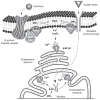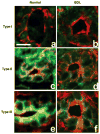Calcium signaling in the liver
- PMID: 23720295
- PMCID: PMC3986042
- DOI: 10.1002/cphy.c120013
Calcium signaling in the liver
Abstract
Intracellular free Ca(2+) ([Ca(2+)]i) is a highly versatile second messenger that regulates a wide range of functions in every type of cell and tissue. To achieve this versatility, the Ca(2+) signaling system operates in a variety of ways to regulate cellular processes that function over a wide dynamic range. This is particularly well exemplified for Ca(2+) signals in the liver, which modulate diverse and specialized functions such as bile secretion, glucose metabolism, cell proliferation, and apoptosis. These Ca(2+) signals are organized to control distinct cellular processes through tight spatial and temporal coordination of [Ca(2+)]i signals, both within and between cells. This article will review the machinery responsible for the formation of Ca(2+) signals in the liver, the types of subcellular, cellular, and intercellular signals that occur, the physiological role of Ca(2+) signaling in the liver, and the role of Ca(2+) signaling in liver disease.
Figures




References
-
- Adams JM, Cory S. The Bcl-2 protein family: Arbiters of cell survival. Science. 1998;281:1322–1326. - PubMed
-
- Alonso MT, Garcia-Sancho J. Nuclear Ca(2+) signalling. Cell Calcium. 2011;49:280–289. - PubMed
-
- Alpini G, Glaser SS, Ueno Y, Pham L, Podila PV, Caligiuri A, Lesage G, Larusso NF. Heterogeneity of the proliferative capacity of rat cholangiocytes after bile duct ligation. Am J Physiol. 1998;274:G767–G775. - PubMed
-
- Alpini G, Lenzi R, Zhai WR, Slott PA, Liu MH, Sarkozi L, Tavoloni N. Bile secretory function of intrahepatic biliary epithelium in the rat. Am J Physiol. 1989;257:G124–G133. - PubMed
Publication types
MeSH terms
Grants and funding
LinkOut - more resources
Full Text Sources
Other Literature Sources
Miscellaneous

